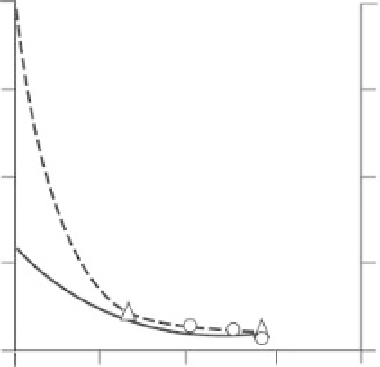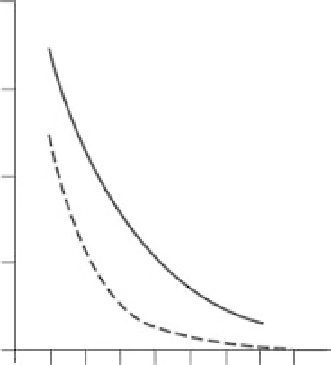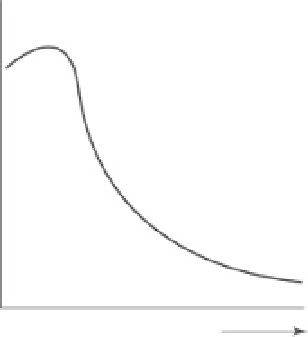Environmental Engineering Reference
In-Depth Information
100
4
100
n =14
75
75
3
n =12
50
50
2
HI
25
25
1
LI
0
0
0
0
25 50 75 100
Percent mean seasonal vegetal cover
0
10
20304050607080
Percent vegetation cover
(a)
(b)
Vegetation
(c)
Figure 24.1
Exponential relationships between erosion rate and vegetation cover: (a) the exponential decrease of erosion as
vegetation cover increases (after Elwell and Stocking, 1976); (b) the effect of high and low intensity rainfall on exponential decrease
of erosion (after Francis and Thornes, 1990); and (c) the effect of intermittent bushes on the exponential decrease of erosion at low
densities.
the carrying capacity is at level
K
v
. The rate of growth
converges asymptomatically on to
K
v
. If too much vege-
tation is produced, then the system is said to overshoot
and it will fall again until it converges on
K
v
. This pattern
of growth has been demonstrated empirically. The steep
part of the growth, between
t
1
and
t
2
, results frompositive
feedback. In this time period, more vegetation encour-
ages growth, so that the rate of growth depends on the
existing vegetation biomass. As vegetation growth occurs,
it provides organic matter to the soil, which provides
more nutrients and better soil water-holding capacity.
There is, we suppose, a limit to the maximum possible
growth, determined by the available moisture. This limit
is, generally, of the order of 1-5 kgm
−
2
of biomass in
semi-arid areas, so that in Almeria, Spain, the standing
biomass is approximately 3 kgm
−
2
, with a rainfall of
300mm (Francis and Thornes, 1990).
Obando (1997) studied a range of abandoned
fields of different ages in Murcia Province, Spain. By
measuring the biomass, she was able to plot the amount
of biomass after different periods of regeneration.
The results confirmed a logistic pattern of growth.
Similarly Godron
et al
. (1981) estimated the recovery
of Mediterranean vegetation after fire and again this
recovery was shown to follow the logistic form.
Obando (1998) also modelled plant production on
abandoned land, using a plant-growth model developed
byThornes (1990) on the basis of Tilman's resource-based




Search WWH ::

Custom Search